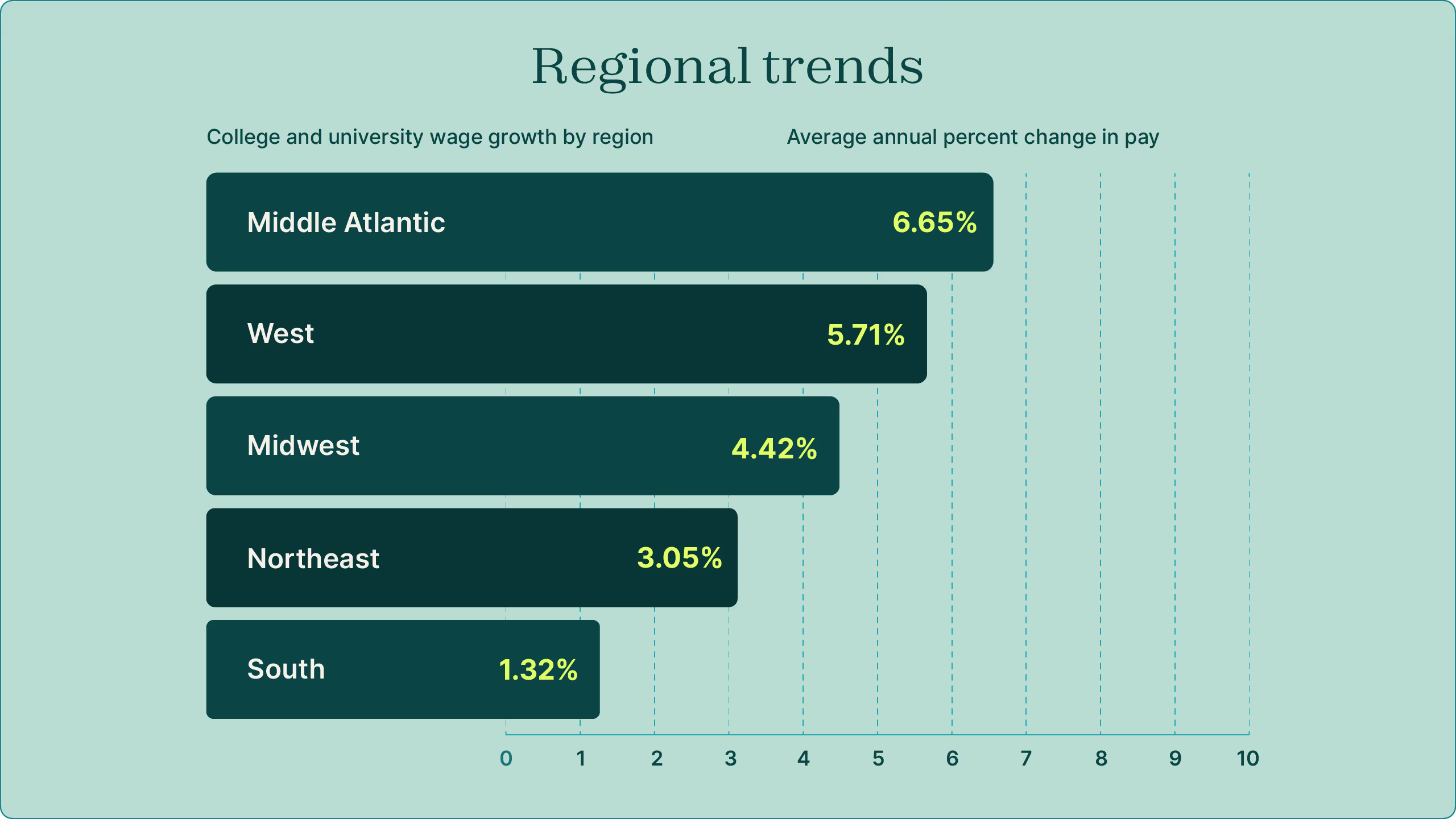Many HR practitioners in higher education are operating under budget constraints not seen in decades.
With uncertainty over federal funding and questions about the value of a four-year degree, America’s colleges and universities face tough challenges: How do you retain talent when budgets shrink? What happens to faculty salaries when enrollment drops?
Employees in higher ed frequently cite low pay in exit data, and more than half feel unfairly compensated. Salary increases continue to lag inflation and pay compression is driving voluntary turnover.
It makes sense that comp professionals in high ed rate the availability of industry-specific market data as their most important need. Access to accurate job pricing becomes critical when every pay decision is under a microscope.
The market landscape is only intensifying this pressure. Colleges and universities are competing against lavish private sector salaries, but their ability to respond varies widely by institution and region.

The data reveals a complex picture. Liberal arts colleges in the Northeast face declining enrollment, while those in the South have seen a surge.
However, this apparent advantage is offset by state funding cuts in several Southern states, creating different but equally challenging budgetary pressures.
These increases may also be deceiving as many colleges and universities are still playing catch-up after a decade of stagnant wage growth. An article from the Chronicle of Higher Ed shows that faculty salaries have decreased by 1.5 percent since 2013 after adjusting for inflation.
Beyond looking the broad trends, compensation professionals require granular salary data from similar institutions. Market pricing depends on distinguishing between institutional types — public versus private, four-year versus two-year, R1 versus teaching colleges, etc. With tighter budgets across the board, drilling down into the data from your peers is necessary for a coherent comp strategy.
Colleges and universities consistently rank industry-specific marketing pricing as their primary consideration in data quality. Payscale’s Peer Industry Network for Colleges and Universities not only delivers benchmarks straight from neighboring institutions. They also connect you with like-minded HR practitioners in higher ed to grow your comp expertise.
Connect with your compensation tribe
The hottest jobs in higher ed
Some roles in higher education have seen higher-than-average pay progression despite budget constraints.

Investment Directors lead the list for good reason. As funding from federal and state government shrinks, growing private endowments become a lifeline to solvency.
One point worth clarifying from above: the reported salaries of adjunct professors are likely a statistical error. The adjunctification of the American professoriat has been a necessary cost-saving measure for institutions of higher ed.
Typically paid by the class or on an hourly basis, our data tabulates the annualized salary of adjunct professors. Adjunct teachers traditionally do not receive salaries like their full-time peers.
While budget-friendly adjuncts have become more common, the appearance of other roles is a telling sign of shifting priorities. Notably, Enrollment Specialists and Career Development Coordinators are included on the list despite modest overall salaries.
With an increasing number of Americans questioning the relevance of traditional degrees, institutions have responded with alternative skills-based educational pathways.
From certifications to accelerated degrees, the appeal of these programs lies in their cost-effectiveness and direct route to employment. Institutions are rethinking the 120-credit hour model in favor of expanding programs with skills-based training.
Staff with academic program expertise and knowledge of career opportunities will likely grow alongside employer demands for graduates with job-ready skills and students’ appetite for guaranteed employment.
Higher ed jobs with declining wage growth
The jobs with cooling wage growth in higher education also tell a story.

A 2023 survey by CUPA-HR (College and University Professional Association for Human Resources) shows that staff in Student Affairs are at the highest risk of attrition.
Roles such as Student Services Center Manager, Cultural Services Manager, Academic Counselor, and Student Services Coordinator fall into this category.
While Enrollment Specialists and Career Development Managers do as well, the pay gap between an Enrollment Specialist and an Admissions and Enrollment Manager may indicate a flattening of the job hierarchy in higher ed.
Enrollment Specialists are the least compensated of all the above roles, lending credence to the argument that colleges and universities have become more budget conscious.
Recent cost assessments across higher education have revealed excessive staffing and overextended programs at many institutions. Nearly half of college presidents argue that some programs should close.
Against this backdrop of closures and cuts, HR practitioners face a different imperative from decades past: creating creative compensation packages within realistic constraints.
If competing dollar-for-dollar with other industries isn’t feasible, a thoughtful EVP and benefits design can help bridge the gap.
But first you need credible market data. Rather than relying on traditional industry surveys, Payscale’s Peer Industry Network for Colleges and Universities delivers an entirely different experience with easy and effortless industry-specific benchmarks from comparable institutions.
Beyond the data itself, Peer for Colleges and Universities offers something equally valuable with access to HR practitioners in your field confronting the same challenges.
Whether you’re wrestling with pay compression or revising your comp structures, you can tap into a network of colleagues who’ve dealt with the same issues. These relationships provide insights no survey can capture.






.avif)